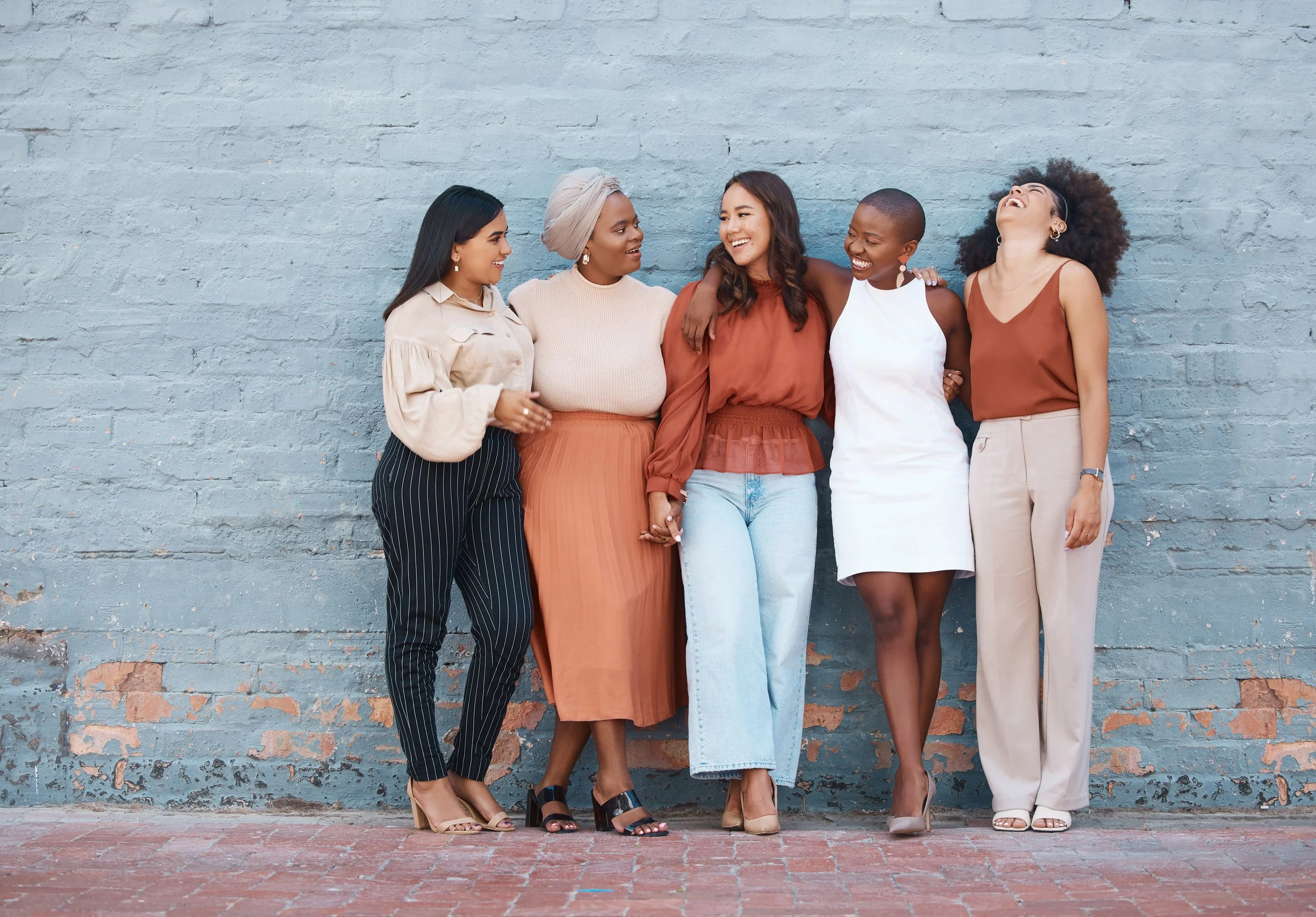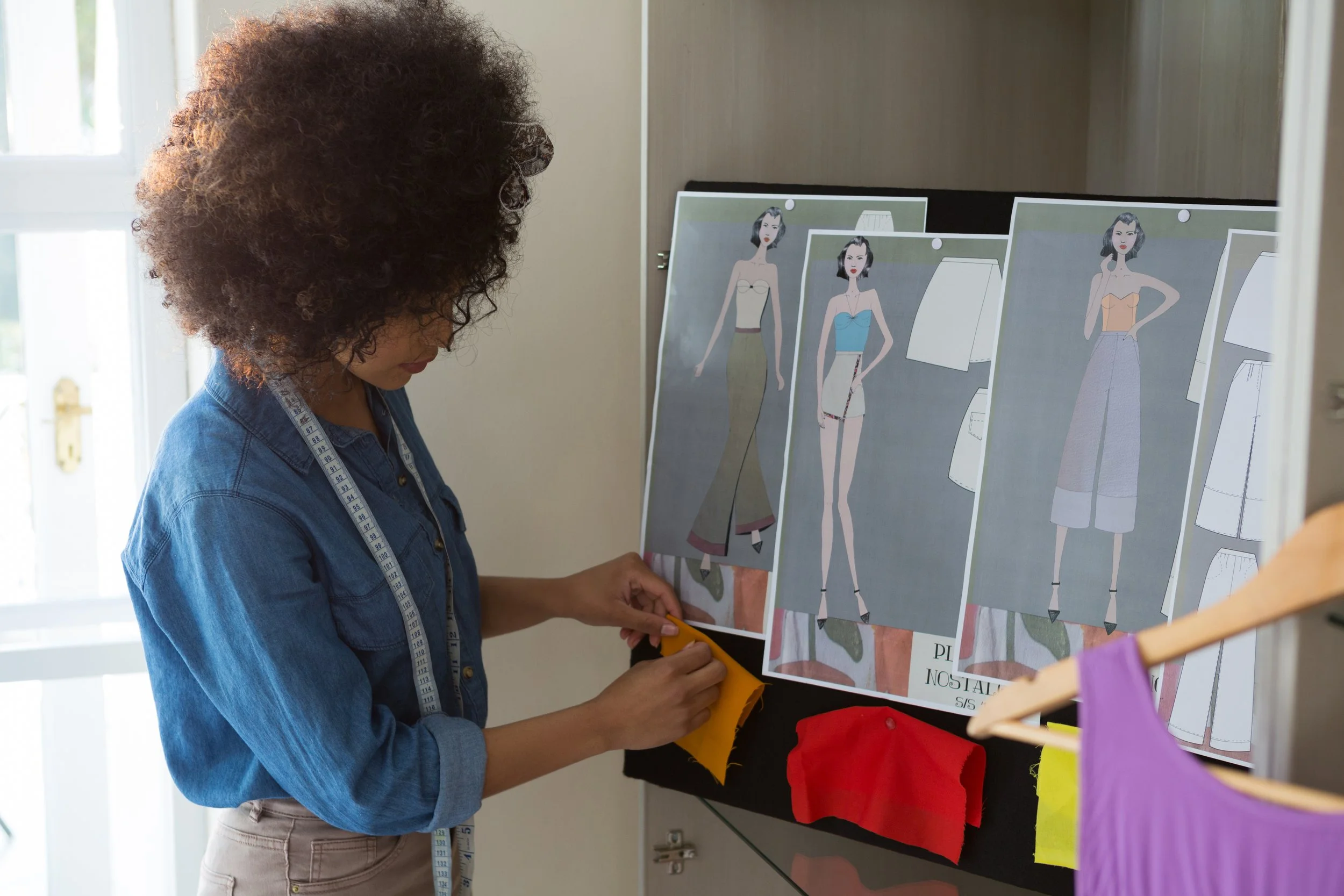From Sizing Charts to Self-Love: Rewriting Your Fashion Story
Get this mental image: I'm standing in a fluorescent-lit dressing room at Target, wrestling with what can only be described as a straight-size sweater that has somehow transformed into a medieval torture device. My arms are trapped above my head; the fabric stretched so tight across my chest that I'm pretty sure I can hear my dignity crying. Meanwhile, my head is completely engulfed in a cashmere blend, and I'm starting to panic because, Plot flip, I can't actually breathe.
This is the moment I realize I've become a human beanie. A very expensive, very stuck human beanie.
After what feels like an eternity of contorting my body into positions that would make a yoga instructor weep, I finally emerge, hair looking like I've been electrocuted, mascara smudged under my eyes like a raccoon who's given up on life. The sweater, meanwhile, lies crumpled on the floor like a defeated enemy, its size "M" tag mocking me with the audacity of a label that clearly doesn't understand physics.
But here's the thing that really gets me: in that moment of fabric-induced claustrophobia, I wasn't thinking about the sweater's poor construction or questioning why a "medium" felt like it was designed for a very small child. No, I was spiraling into that familiar mental loop of "maybe I should skip lunch for the next three weeks" and "When did I become too big for a medium?"
Why do those tiny numbers on a tag, numbers that vary wildly from brand to brand, store to store, and apparently planet to planet, hold such devastating power over our moods, our weekend plans, and our fundamental sense of self-worth?
The Tyranny of the Tag
Let's talk about the beautiful disaster that is sizing charts, shall we? Somewhere in fashion history, some executive in a boardroom probably said, "You know what would be fun? Let's create a numbering system that makes absolutely no sense and changes based on whatever we feel like that Tuesday." And thus, the modern sizing apocalypse was born.
Here's the thing about that magical 0-16 scale: it's about as reliable as a weather forecast in March. A size 8 at H&M might as well be a size 12 at Anthropologie, which could be a size 6 at Old Navy, which definitely isn't the same as a size 8 at Target. It's like each brand has its own secret language, and we're all just stumbling around trying to crack the code with our credit cards and rapidly diminishing self-esteem.
I once bought three pairs of jeans in the same size from three different stores. One pair made me look like I was wearing a teenager's clothes, one fit like a glove, and one required me to lie down on my bed and perform actual acrobatics to zip up. "And get this? They were all labeled size 10. At this point, I'm convinced sizing charts are just elaborate pranks played by fashion designers who clearly have too much time on their hands.
And don't even get me started on the emotional rollercoaster of "plus size" versus "extended sizes" versus "curvy fit." It's like navigating a minefield of euphemisms, each one carrying its own baggage and judgment. You'll find yourself in the "women's" section, wondering if you've somehow aged out of regular clothes or standing in front of a rack labeled "extended sizes," feeling like you need a permission slip from society to shop there.
The truth is, we're all just trying to find that magical combination of fabric and thread that makes us feel like ourselves. Still, instead, we're playing a twisted game of numerical roulette where the house always wins, and we always leave feeling slightly defeated.
Emotionally Charged Insecurities
Remember that moment in college when you tried on a bridesmaid dress and had a full-scale meltdown in a curtained stall barely big enough for one person, let alone one person having an existential crisis? Yeah, me too. There's something particularly brutal about those communal dressing room experiences where you can hear other women sighing with frustration, the sound of zippers refusing to cooperate, and that universal "Does this look okay?" question that hangs in the air like a prayer.
The emotional toll of fashion sizing goes way deeper than just inconvenience. It's the way your heart sinks when you have to ask for a bigger size or the secret relief you feel when you can fit into something smaller than expected as if your worth as a human being somehow correlates with the number sewn into your clothes. It's the generational echo of your mother's voice saying, "You'd be so pretty if you just lost a little weight," or your grandmother's well-meaning but devastating observation that "you've got such a pretty face."
Social media has turned this personal struggle into a full-contact sport. We're scrolling through Instagram, seeing influencers effortlessly wearing size 2 everything, while we're over here googling "how to make size 8 jeans look like size 6 jeans" at 2 AM. The comparison trap is real, and it's vicious, and it's probably why we all have at least one friend who texts before every social gathering with "Do I look okay in this?" followed by seventeen different angles of the same outfit.
And let's be honest about that text. When you send it, you're not really asking if you look okay. You're asking if you look worthy of being seen if you deserve to take up space in the world if you're allowed to exist in your body without apology. That's a lot of pressure to put on a simple outfit, but here we are, treating our wardrobes like they're somehow responsible for our entire sense of self-worth.
Moments of Grace & Self-Love
But then something beautiful happens. Maybe it's the first time you walk into a store and find a brand that actually understands your body, where the size that fits you is just a number, not a judgment. Maybe it's the moment your daughter looks at you getting ready for date night and says, "Mommy, you look so pretty!" with such genuine admiration that you actually believe her. Maybe it's discovering that one perfect dress that makes you feel like you could conquer the world, regardless of what the tag says.
These moments of grace sneak up on us when we least expect them. For me, it was discovering that I look amazing in my husband's oversized T-shirts, worn as a dress with a belt and some confidence. Suddenly, the size XL that used to feel like a scarlet letter became my secret weapon, my comfort zone, my "don't mess with me, I'm fabulous" uniform.
The body-positive movement has permitted us to celebrate these moments, to share them, to build communities around the radical idea that we're allowed to love ourselves exactly as we are. Following influencers who look like real humans, who show their cellulite and talk about size fluctuations, who wear whatever makes them happy regardless of conventional fashion rules, it's like having a group of friends who remind you that you're not crazy for wanting to feel good in your own skin.
I started practicing what I call "mirror minimalism," spending less time analyzing my reflection and more time focusing on how clothes feel. Does this dress make me want to dance? Do these jeans let me move freely? Does this top make me smile when I put it on? These became my new sizing metrics, infinitely more reliable than any number on a tag.
Practical Rewrites for Your Fashion Story
Ready to stage your own fashion revolution? Here's how to rewrite your relationship with clothing, one outfit at a time:
Size-less Shopping: Focus on cut, color, and comfort instead of hunting for that perfect number. Flowy tops that don't cling, high-waisted jeans that sit where they're supposed to, and dresses with adjustable straps, these are your allies. Embrace accessories: a great belt can transform any outfit, scarves add personality without requiring a specific size, and layering pieces give you infinite styling options.
The Label Swap Ritual: Once a week, buy one piece outside your comfort size. It could be an oversized blazer from the men's section or a cropped top you'd never usually consider. The goal isn't to wear everything. It's to break your brain's association between size and worth.
Community Closet Parties: Host gatherings where friends bring clothes they no longer wear. There's something magical about seeing your friend light up in a dress you never quite felt right in or discovering that your "too small" top is someone else's perfect fit.
Outfit Amnesty: If something doesn't fit the way you want it to, don't torture yourself trying to make it work. Donate it, sell it, or turn it into pajamas. Your closet should be a source of joy, not a daily reminder of perceived inadequacies.
A Rallying Conclusion
I still think about that Target dressing room sometimes, but now I laugh instead of cringe. That sweater wasn't wrong, and neither was I. We just weren't meant to be together, and that's okay. I've learned that fashion is supposed to serve us, not the other way around.
Everybody deserves to look, feel, and dance like they belong on a runway of one. Your runway. Your rules. Your celebration of the skin you're in and the life you're living. The numbers on those tags? They're just suggestions, and you have the final say.
So here's my challenge to you: tomorrow, ignore the size tag. Walk into a store and try on something just because it speaks to you. Maybe it's a color you've never worn, a style you've admired from afar, or a piece from a section you've never shopped. Try it on with curiosity instead of judgment, with excitement instead of dread.
Because somewhere out there, a little girl is watching her mother get dressed for work, and she's learning what it means to exist in a body. She's absorbing whether clothes are joy or judgment, whether mirrors are friends or enemies, whether her worth lives in her skin or her spirit.
That little girl deserves to see you twirl in whatever makes you happy. She deserves to hear you say, "I look amazing," instead of "I look fat." She deserves to witness a woman who knows that true style isn't about fitting into someone else's idea of the perfect size; it's about fitting perfectly into your own life, your own dreams, and your own beautifully imperfect story.
Your fashion story is still being written, and you're the author. But remember: you're not just writing it for you. You're writing it for every woman who will watch you choose self-love over self-doubt, confidence over comparison, joy over judgment.
Make it a story worth inheriting.
By Sypharany.





